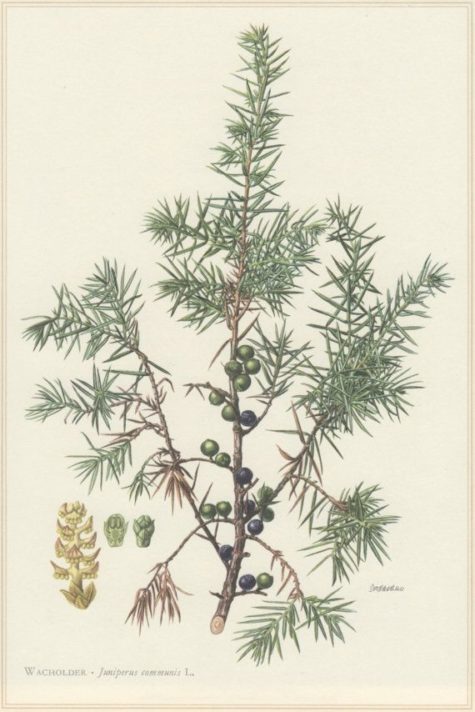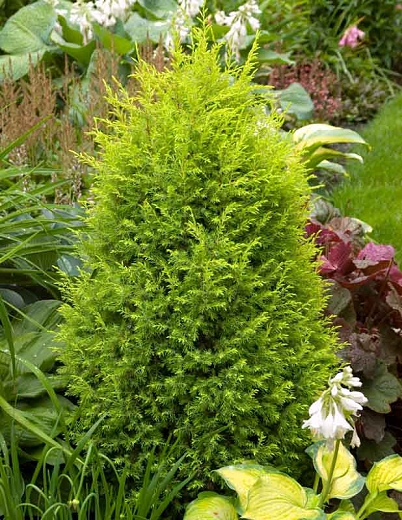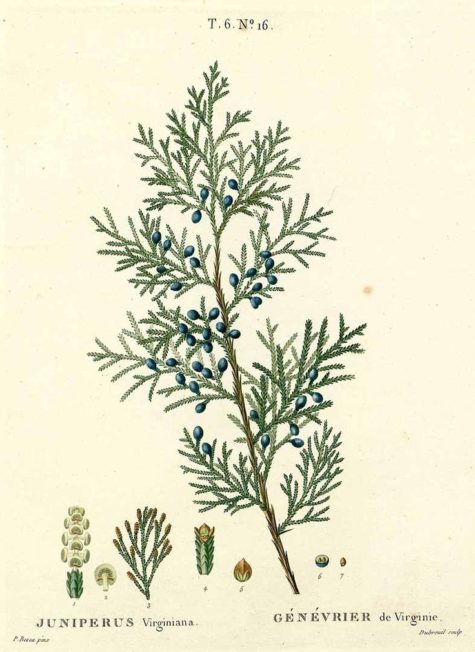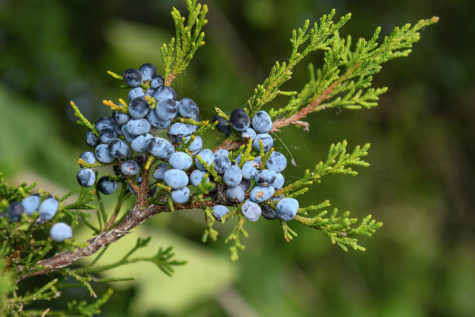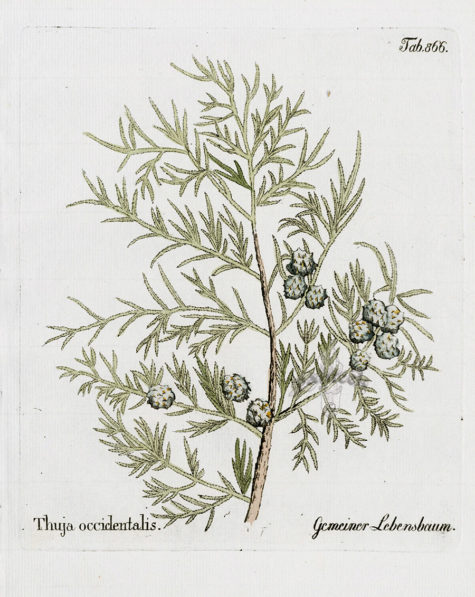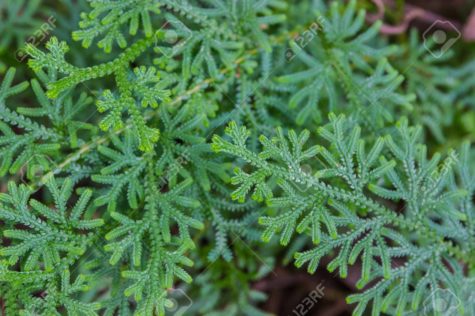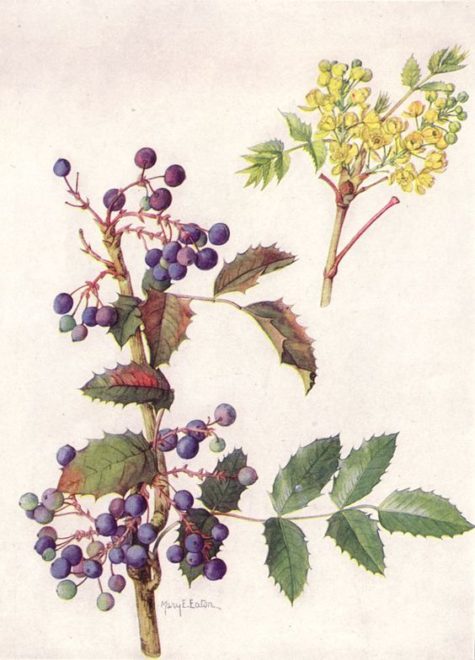Evergreen Medicinals
Juniper
- Scientific Name: Juniperus, communis
- Plant Family: Pinaceae
- Parts Used: Berries, leaves and twigs, bark
- Constituents: Rich in essential oil which contains monoterpenes and sesquiterpenes, invert sugar, flavone glyosides, resin, tannin, organic acids
- Actions: Diuretic, Stimulant, Carminative, Emmenagogue, Antimicrobial, Anti-rheumatic, Abortifacient
- How does it work? Juniper berries contain chemicals that might decrease swelling. It might also be effective in fighting bacteria and viruses. Juniper might also increase the need to urinate.
Varieties:
There are over sixty Juniper species, but the one which yields edible fruits in Britain is Juniperus comunis. In the Americas, Eastern Red Cedar, Juniperus virginiana, can be used in much the same way. A detailed account of the herbal properties of Eastern Red Cedar can be found here.
Among the varied forms, there are dense, columnar trees; medium sized, rounded shrubs; irregular bush forms; and creeping prostrate types. Irish and Swedish junipers are tall, narrow, and quick growing; the Greek and Chinese are very compact, slow growing. Pfitzers are irregular, massive types. California Juniper may reach heights of 40 feet, and shore Juniper and japonica are spreading ground covers.
Notes and Cautions:
One useful guide to the identification of Juniper is the apple-like fragrance that the needle-shaped leaves give off when crushed.
Women who are pregnant, wish to become pregnant, or who are nursing a child should not eat Juniper fruits. Due to their action on the kidneys, Juniper berries should be avoided by persons with kidney disease.
Don’t confuse Juniper berry oil with cade oil, which is distilled from Juniper wood (Juniperus oxycedrus).
The Basics:
A strong aromatic scent emanates from all parts of the shrub. Berries taste slightly bitter-sweet, fragrant, and spicy and are generally used to make a tea that is good for flatulence and indigestion, to promote the flow of urine.
Juniper branches can be used as a fumigant and were commonly burned in public places in times of plague and pestilence. This was still the practice in French hospitals a century ago during the smallpox epidemic of 1870.
Juniper berries make an excellent antiseptic in conditions such as cystitis. The essential oil present is quite stimulating to the kidney nephrons and so this herb should be avoided in kidney disease. The bitter action aids digestion and eases flatulent colic. It is used in rheumatism and arthritis. Externally it eases pain in the joints or muscles.
Some people take Juniper by mouth for problems with digestion, urinary tract infections (UTIs), and kidney and bladder stones along with many other conditions. Some people apply Juniper directly to the skin for wounds and pain in joints and muscles.
In foods, Juniper berry is often used as a condiment. The extract, oil, and berry are used as flavoring ingredients in foods and beverages. In manufacturing, Juniper extract and oil are used as fragrances in soaps and cosmetics.
The Other Cedars
Cedar is part of the English common name of many trees and other plants, particularly those of the genus Cedrus. Some botanical authorities consider Cedrus the only “true cedars”. Several species of genera Calocedrus, Thuja, and Chamaecyparis in the Pacific Northwest with similarly aromatic wood are referred to as “false cedars”.
Most often, when books on herbs talk about Cedar, they are referring to White Cedar which is also known as Arborvitae (Thuja occidentalis). But sometimes, they are referring to Eastern Red Cedar (Juniperus virginiana), and also Junipers in general. The information on Cedars in general tends to be confusing, at least to me, because the names overlap.
With this post, I hope to clear up a little bit of that confusion. You will not find a lot of medicinal information listed here, my goal was to simply to provide a small amount of clarity when it comes to references to “Cedar.”
Here is a quick list of trees and shrubs that are often referred to as Cedars:
Family Pinaceae – Cedrus, common English name cedar, a genus of coniferous trees in the plant family Pinaceae.
- Lebanon cedar (Cedrus libani) a cedar native to Lebanon, western Syria and south central Turkey. For more info see below.
- Atlas cedar (Cedrus atlantica) a cedar native to the Atlas Mountains of Morocco and Algeria.
- Deodar cedar (Cedrus deodara) a cedar native to the western Himalayas
- Cyprus cedar (Cedrus brevifolia) classified mainly to distinguish it from the Cedar of Lebanon, found in the island of Cyprus’s Cedar Valley in the Troodos Mountains
- Siberian pine (Pinus sibirica) occasionally erroneously referred to as Siberian cedar
Family Cupressaceae – The family is notable for including the largest, tallest, and stoutest individual trees in the world, and also the second longest lived species in the world:
- Atlantic white cedar or (Chamaecyparis thyoides)
- Bermuda cedar (Juniperus bermudiana) a species of juniper endemic to Bermuda
- Chilean cedar (Austrocedrus chilensis)
- Clanwilliam cedar (Widdringtonia cedarbergensis) a species of cypress endemic to the Cederberg mountains of South Africa.
- Eastern red cedar (Juniperus virginiana) a species of juniper native to eastern North America. . An in depth look can be found here: Red Cedar.
- Eastern white cedar (Thuja occidentalis). An in-depth look can be found here: Thuja aka Arborvitae.
- Incense-cedar (Calocedrus)
- Iranian cedar (Cupressus sempervirens)
- Japanese cedar (Cryptomeria japonica) known as 杉 (Sugi) in Japanese.
- Mexican white cedar (Cupressus lusitanica) a species of cypress native to Mexico and Central America.
- Mountain cedar (Juniperus ashei) an evergreen shrub native to northeastern Mexico and the south central United States.
- New Zealand cedar (Libocedrus bidwillii). For more info, see below.
- Northern white cedar (Thuja occidentalis)
- Persian cedar (Cupressus sempervirens)
- Port Orford-cedar (Chamaecyparis lawsoniana)
- Prickly cedar (Juniperus oxycedrus) native across the Mediterranean region. For more info, see below.
- Sharp cedar (Juniperus oxycedrus) native across the Mediterranean region.
- Western red cedar (Thuja plicata) a cypress of the Pacific northwest. For more info, see below.
- Yellow cedar (Cupressus nootkatensis) also called Alaska cedar and (Callitropsis nootkatensis)
Family Meliaceae – the mahogany family, is a flowering plant family of mostly trees and shrubs (and a few herbaceous plants, mangroves) in the order Sapindales.
- Spanish cedar (Cedrela odorata). For more info, see below.
- Cigar-box cedar (Cedrela)
- Australian red cedar (Toona ciliata or T. australis)
- Ceylon cedar (Melia azedarach) a species of deciduous tree native to India, southern China and Australia
Other families:
- Bay cedar (Suriana, Surianaceae)
- Running cedar or ground cedar, various species of clubmosses (Lycopodiopsida) in the genus Diphasiastrum
- Saltcedar, Tamarix (Caryophyllaceae)
- Stinking cedar (Torreya taxifolia, Cephalotaxaceae)
- Warren River cedar or native cedar (Taxandria juniperina, Myrtaceae)
- White cedar or Haitian cedar (Tabebuia heterophylla, Bignoniaceae). See below for more info.
From M. Grieve’s Modern Herbal we have these short and somewhat unsatisfactory descriptions of some of the other cedars, including a few of those listed above. I have also included information found on Wikipedia and elsewhere. Continue reading
Eastern Red Cedar
- Scientific Name: Juniperus virginiana
- Parts Used: Berries (female cones), branches, leaves, bark
- Actions: Anti-inflammatory, Diaphoretic, Expectorant, Astringent, Antimicrobial, Diuretic, Antiasthmatic, Antifungal
The uses of Eastern Red Cedar branch out into many. They are very similar to the Old World, standard Common Juniper in that its female cones- or berries- are one of its favored usable parts, if not an attribute of the plant that really grabs the eye. When you see the Cedar’s fragrant branches heavily-laden with these bright blue little “fruits,” it’s hard for an herbalist to think that these are NOT somehow useful!
One of the virtues of the berry is that it goes impeccably well with several mediums: salve, tincture, elixir, syrup, you name it. What more: it tastes delicious, and mixes well with a large variety of other herbal flavors in combination, if you are crafting a blend or formula of sorts. The twigs, leaves, branches and bark of Cedar have effects and flavor too, although they are notably more intense and astringent, having a reputation of being hard to extract; their use is important, but not as eclectic.
I would wager that the berries are more for tonic use, whereas the rest of this beautiful plant should be saved for acute situations, which I will get to later. Berries can be picked during the fall or winter, as they last, when they “ripen” to an appetizing-looking blue.
Remember: Cedar trees tend to be dioecious (at least the Eastern Reds are). That is, there are males and females of the species. If it is fall or winter, and the trees you are looking at for harvesting don’t seem to have blue cones, chances are they are male. Keep looking– you will more than likely stumble upon a female tree not far off.
In its many mediums, the berries serve as a very ideal winter medicine– all the better since they can, for the most part, be harvested all winter as the berries are available. They are high in Ascorbic Acid, or Vitamin C, an ideal vitamin to take over the winter for immune support. Even if you don’t have a cold, their use as a tonic will be more than welcome.
When winter illnesses take a nasty turn, Eastern Red Cedar berries work with expectorant action, helping the lungs clear out excess mucus and promote a healthy cough. It can be useful for a dry or wet cough: it relieves that “tickle” you may feel with a scratchy, dry throat with a hoarse cough, but it also stimulates the lungs to cough more productively, and expel phlegm in less time than without it. So here you have a medicine that stimulates the immune system, relieves a scratchy throat, improves your cough– and tastes great!
Cedar berries in syrup form are especially delightful. Sounds like quite a valuable ally to have, if you ask me.
Medicinal Uses
The young leafy twigs of the red cedar were officially listed in the U.S. Pharmacopoeia from 1820 to 1894 as a diuretic. The distilled oil of the red cedar has been officially listed as a reagent in the U.S. Pharmacopoeia since 1916.
The berries in decoction are diaphoretic and emmenagogue, like those of Common Juniper, and the leaves have diuretic properties.
People take Eastern red cedar for cough, bronchitis, joint pain (rheumatism), water retention, and flatulence. They also take it to improve appetite and digestion, and as a treatment for fungal infections and worms.
People apply Eastern red cedar to the skin for wounds, skin rashes, hair loss, eczema, acne, warts, fungal skin infections, and hemorrhoids. They also rub it onto joints for rheumatism, and onto the chest for asthma.
In the Native-Hispanic tradition, Cedars and their relatives are valued highly for the properties of their leaves, “needles,” or branches. These hold the more potent effects of the tree, and as such, are more difficult to capture in preparations. They can be slightly toxic.
The berries are used when there are excess fluids in the body, but Juniper really shines when the kidneys are sluggish, dilating tissues to increase urine flow, and reducing excess mucus production. It’s diuretic actions are truly remarkable, and is indicated in many cases of edema. Those berries are irritating, though, and are not recommended in large doses, for long-term use, and definitely not for those with kidney problems.
Eating 3-5 fresh berries is suggested for an upset stomach. It is thought the bitter nature stimulates gastric juices and improves digestion.
While certainly not widely considered poisonous or dangerous, it is still good to be careful. Be sparing when using preparations of Cedar needles or branches, even the berries, for that matter. Cedars are very powerful diuretics. When taken overboard, they cause kidney irritation, which feels like cramping in the abdomen– similar to a period cramp. Even higher doses can be more dangerous. Folks with weak kidneys, or outstanding kidney issues should avoid using the Cedar leaf.
Thuja aka Arborvitae
- Parts Used: Young twigs
- Constituents: 1% volatile oil including thujone, flavonoid glyoside, musilage, tannin.
- Actions: Expectorant, Stimulant to smooth muscles, Diuretic, Astringent, Alterative, Anthelmintic, Diaphoretic, Emmenagogue
- Cautions: Avoid during pregnancy. Taken in excess the essential oil can produce unpleasant results; it was officially listed as an abortifacient and convulsant in overdose.
Thuja is a genus of coniferous trees in the Cupressaceae (cypress family). There are five species in the genus, two native to North America and three native to eastern Asia.
- White Cedar – Thuja occidentalis
- Western Red Cedar – Thuja plicata
- Korean Thuja – Thuja koraiensis
- Japanese Thuja – Thuja standishii
- Sichuan Thuja – Thuja sutchuenensis
Members are commonly known as arborvitaes, (from Latin for tree of life) Thujas or Cedars. The name Thuja is a latinized form of a Greek word meaning ‘to fumigate,’ or thuo (‘to sacrifice’), for the fragrant wood was burnt by the ancients with sacrifices. The tree was described as ‘arbor vita ‘ by Clusius, who saw it in the royal garden of Fontainebleau after its importation from Canada.
The Basics
Most of the herbal information I found on Thuja refers specifically to Thuja occidentalis – White Cedar, or Arborvitae – but it is possible that the other varieties share similar characteristics and qualities.
- It is important not to confuse the Western Red Cedar (Thuja plicata) with the Eastern Red Cedar (Juniperus virginiana) as the two are quite different.
The name arborvitae is particularly used in the horticultural trade in the United States. It is Latin for “tree of life” – due to the medicinal properties of the sap, bark, and twigs. Despite its common names, it is not a true cedar in the genus Cedrus, nor is it related to the Australian white cedar, Melia azedarach.
Thuja is used for respiratory tract infections such as bronchitis, bacterial skin infections, and cold sores. It is also used for painful conditions including osteoarthritis and a nerve disorder that affects the face called trigeminal neuralgia.
Some people use Thuja to loosen phlegm (as an expectorant), to boost the immune system (as an immunostimulant), and to increase urine flow (as a diuretic). It has also been used to cause abortions.
Thuja is sometimes applied directly to the skin for joint pain, ostearthritis, and muscle pain. Thuja oil is also used for skin diseases, warts, and cancer; and as an insect repellent.
In foods and beverages, Thuja is used as a flavoring agent. In manufacturing, Thuja is used as a fragrance in cosmetics and soaps.
According to WebMD, Thuja contains chemicals that might fight viruses. It also contains a chemical called thujone that can cause brain problems.
Oregon Grape
- Scientific Name: Berberis Aquifolium
- Common Name: Barberry
- Plant Family: Berberidaceae
- Parts Used: Rhizome and Roots, Bark, Fruits
- Actions: Alterative, cholagogue, diuretic, laxative and tonic
Description:
Several varieties of the subgenus Mahonia contribute to the drug of commerce under the name of Berberis aquifolium. It is a quickly-growing shrub about 6 feet high: the oddly compound leaves have no spine at the base; they are evergreen and shining. The flowers grow in terminal racemes, are small and yellowish-green in color, and the purple berries are three- to nine-seeded. The bark is brown on the surface and yellow beneath. The root is from 1/2 inch in diameter to 3 inches at the base of the stem, odorless, and with a bitter taste. The shrub was introduced into England from North America in 1823. It was formerly known as Mahonia aquifolia and is very hardy.
Note:It should not be used with Glycyrrhiza species (Liquorice) because this nullifies the effects of the berberine.
The Basics:
Oregon grape was often used by several native North American Indian tribes to treat loss of appetite and debility. Its current herbal use is mainly in the treatment of gastritis and general digestive weakness, to stimulate the kidney and gallbladder function and to reduce catarrhal problems. The root and root bark is alterative, blood tonic, cholagogue, diuretic, laxative and tonic. It improves the digestion and absorption and is taken internally in the treatment of psoriasis, syphilis, haemorrhages, stomach complaints and impure blood conditions. Externally, it has been used as a gargle for sore throats and as a wash for blurry or bloodshot eyes.
The blue fruits are tart and improve after frost. They are often gathered for jelly or wine. Used to treat a wide variety of ailments, Oregon Grape species contain the extremely potent alkaloid, berberine, (also found in goldenseal) which is antiseptic and stimulates the liver and spleen.
The fruit is an excellent gentle and safe laxative. Berberine, universally present in rhizomes of Mahonia species, has marked antibacterial effects and is used as a bitter tonic. Since it is not appreciably absorbed by the body, it is used orally in the treatment of various enteric infections, especially bacterial dysentery.
Berberine has also shown anti-tumor activity.
It is one of the best alterative blood purifiers and liver stimulants. Uses for the Oregon Grape Root include weak digestion, flatulence, jaundice, blood impurities, and as a general tonic to the whole system.
A decoction (instructions below) will be found to be a wonderful blood purifier and will restore health to many who are suffering from a sluggish liver, weak stomach, indigestion, and sallow skin.
Years ago, it was given to children, and said to create appetite and promote digestion, and increase strength and vitality. The current medical thinking is that it is not safe for children, especially infants, or pregnant or nursing women. (see information at the bottom of the post)
Continue reading
Rennie Luttrull: queen-annes-lace-seeds
Rosanna: Spignel aka Bald Money
Annamarie Squatrito: Fumitory
EILEEN Klinghagen: Pumpkin
Mahmudul Hasan: Celery
